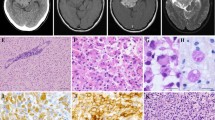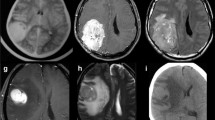Abstract
Pilocytic astrocytomas and low-grade gliomas are more common compared with glioblastomas in patients with neurofibromatosis 1 (NF1). A recent genome-wide analysis has shown frequent NF1 gene alterations in the mesenchymal subtype of a glioblastoma; however, little is known about clinicopathological features of glioblastomas in NF1 patients (NF1 glioblastomas). We analyzed four NF1 glioblastomas. Radiographical and intraoperative findings showed well-circumscribed tumors from surrounding brain. Pathological analysis presented a paucity of processes with an eosinophilic cytoplasm, bizarre nuclei, xanthomatous-like appearance, multinucleated giant cells, and histiocytoid appearance. During the follow-up period, one patient died at 49 months and others remained alive for 60, 87, and 106 months; thus, patients with NF1 glioblastoma presented a relatively favorable survival. None of the NF1 glioblastomas harbored isocitrate dehydrogenase 1 (IDH1) gene mutation, v-RAF murine sarcoma viral oncogene homolog B1 (BRAF) gene mutation, and telomerase reverse transcriptase (TERT) gene promoter mutation. We identified that NF1 glioblastoma is a unique subset of glioblastoma.




Similar content being viewed by others
References
Gutmann DH, Parada LF, Silva AJ et al (2012) Neurofibromatosis type 1: modeling CNS dysfunction. J Neurosci 32:14087–14093
Neurofibromatosis (1988) Conference statement. National Institutes of Health Consensus Development Conference. Arch Neurol 45:575–578
Rasmussen SA, Friedman JM (2000) NF1 gene and neurofibromatosis 1. Am J Epidemiol 151:33–40
Gutmann DH, Rasmussen SA, Wolkenstein P et al (2002) Gliomas presenting after age 10 in individuals with neurofibromatosis type 1 (NF1). Neurology 59:759–761
Rodriguez FJ, Perry A, Gutmann DH et al (2008) Gliomas in neurofibromatosis type 1: a clinicopathologic study of 100 patients. J Neuropathol Exp Neurol 67:240–249
Verhaak RG, Hoadley KA, Purdom E et al (2010) Integrated genomic analysis identifies clinically relevant subtypes of glioblastoma characterized by abnormalities in PDGFRA, IDH1, EGFR, and NF1. Cancer Cell 17:98–110
Alexandrescu S, Korshunov A, Lai SH et al (2016) Epithelioid glioblastomas and anaplastic epithelioid pleomorphic xanthoastrocytomas-same entity or first cousins? Brain pathology 26:215–223
Kleinschmidt-DeMasters BK, Aisner DL, Birks DK et al (2013) Epithelioid GBMs show a high percentage of BRAF V600E mutation. Am J Surg Pathol 37:685–698
Singh G, Das KK, Sharma P et al (2015) Cerebral gliosarcoma: analysis of 16 patients and review of literature. Asian J Neurosurg 10:195–202
Sonoda Y, Yokosawa M, Saito R et al (2010) O (6)-Methylguanine DNA methyltransferase determined by promoter hypermethylation and immunohistochemical expression is correlated with progression-free survival in patients with glioblastoma. Int J Clin Oncol. https://doi.org/10.1007/s10147-010-0065-6
Shibahara I, Sonoda Y, Kanamori M et al (2012) IDH1/2 gene status defines the prognosis and molecular profiles in patients with grade III gliomas. Int J Clin Oncol 17:551–561
Shibahara I, Sonoda Y, Saito R et al (2013) The expression status of CD133 is associated with the pattern and timing of primary glioblastoma recurrence. Neuro Oncol 15:1151–1159
Fransen K, Klintenas M, Osterstrom A et al (2004) Mutation analysis of the BRAF, ARAF and RAF-1 genes in human colorectal adenocarcinomas. Carcinogenesis 25:527–533
Sonoda Y, Kumabe T, Nakamura T et al (2009) Analysis of IDH1 and IDH2 mutations in Japanese glioma patients. Cancer Sci 100:1996–1998
Eckel-Passow JE, Lachance DH, Molinaro AM et al (2015) Glioma groups based on 1p/19q, IDH, and TERT promoter mutations in tumors. N Engl J Med 372:2499–2508
Weller M, Felsberg J, Hartmann C et al (2009) Molecular predictors of progression-free and overall survival in patients with newly diagnosed glioblastoma: a prospective translational study of the German Glioma Network. J Clin Oncol 27:5743–5750
Miyata S, Sugimoto T, Kodama T et al (2005) Adenoid glioblastoma arising in a patient with neurofibromatosis type-1. Pathol Int 55:348–352
Kroh H, Matyja E, Marchel A et al (2004) Heavily lipidized, calcified giant cell glioblastoma in an 8-year-old patient, associated with neurofibromatosis type 1 (NF1): report of a case with long-term survival. Clin Neuropathol 23:286–291
Jeong TS, Yee GT (2014) Glioblastoma in a patient with neurofibromatosis type 1: a case report and review of the literature. Brain Tumor Res Treat 2:36–38
Taraszewska A, Bogucki J, Powala A et al (2013) Giant cell glioblastoma with unique bilateral cerebellopontine angle localization considered as extraaxial tumor growth in a patient with neurofibromatosis Type 1. Clin Neuropathol 32:58–65
Louis DN, Ohgaki H, Wiestler OD, Cavenee WK (2016) WHO classification of tumours of the central nervous system, 4th edn. IARC Press, Lyon
Laycock-van Spyk S, Thomas N, Cooper DN et al (2011) Neurofibromatosis type 1-associated tumours: their somatic mutational spectrum and pathogenesis. Hum Genom 5:623–690
Jones DT, Kocialkowski S, Liu L et al (2008) Tandem duplication producing a novel oncogenic BRAF fusion gene defines the majority of pilocytic astrocytomas. Cancer Res 68:8673–8677
Adeleye AO, Okolo CA, Akang EE et al (2012) Cerebral pleomorphic xanthoastrocytoma associated with NF1: an updated review with a rare atypical case from Africa. Neurosurg Rev 35:313–319 (discussion 319)
Takei H, Rouah E, Bhattacharjee MB (2015) Cerebellar pleomorphic xanthoastrocytoma in a patient with neurofibromatosis type 1: a case report and literature review. Int J Clin Exp Pathol 8:7570–7574
Saikali S, Le Strat A, Heckly A et al (2005) Multicentric pleomorphic xanthoastrocytoma in a patient with neurofibromatosis type 1. Case report and review of the literature. J Neurosurg 102:376–381
Naidich MJ, Walker MT, Gottardi-Littell NR et al (2004) Cerebellar pleomorphic xanthoastrocytoma in a patient with neurofibromatosis type 1. Neuroradiology 46:825–829
Hariharan S, Donahue JE, Garre C et al (2006) Clinicopathologic and genetic analysis of siblings with NF1 and adult-onset gliomas. J Neurol Sci 247:105–108
Rutledge WC, Kong J, Gao J et al (2013) Tumor-infiltrating lymphocytes in glioblastoma are associated with specific genomic alterations and related to transcriptional class. Clin Cancer Res 19:4951–4960
Ratner N, Miller SJ (2015) A RASopathy gene commonly mutated in cancer: the neurofibromatosis type 1 tumour suppressor. Nat Rev Cancer 15:290–301
Singh AD, Iftinca M, Easaw JC (2013) Lipidized glioblastoma: pathological and molecular characteristics. Neuropathology 33:87–92
Gupta K, Kalra I, Salunke P et al (2011) Lipidized glioblastoma: a rare differentiation pattern. Neuropathology 31:93–97
Kanamori M, Suzuki H, Takei H et al (2016) Malignant transformation of diffuse astrocytoma to glioblastoma associated with newly developed BRAF V600E mutation. Brain Tumor Pathol 33:50–56
Arita H, Narita Y, Fukushima S et al (2013) Upregulating mutations in the TERT promoter commonly occur in adult malignant gliomas and are strongly associated with total 1p19q loss. Acta Neuropathol 126:267–276
Matsumura N, Nakajima N, Yamazaki T et al (2017) Concurrent TERT promoter and BRAF V600E mutation in epithelioid glioblastoma and concomitant low-grade astrocytoma. Neuropathology 37:58–63
Huttner AJ, Kieran MW, Yao X et al (2010) Clinicopathologic study of glioblastoma in children with neurofibromatosis type 1. Pediatr Blood Cancer 54:890–896
Dahiya S, Emnett RJ, Haydon DH et al (2014) BRAF-V600E mutation in pediatric and adult glioblastoma. Neuro Oncol 16:318–319
Vizcaino MA, Shah S, Eberhart CG et al (2015) Clinicopathologic implications of NF1 gene alterations in diffuse gliomas. Hum Pathol 46:1323–1330
Philpott C, Tovell H, Frayling IM et al (2017) The NF1 somatic mutational landscape in sporadic human cancers. Hum Genom 11:13
Bikowska-Opalach B, Szlufik S, Grajkowska W et al (2014) Pilocytic astrocytoma: a review of genetic and molecular factors, diagnostic and prognostic markers. Histol Histopathol 29:1235–1248
Acknowledgements
We would like to thank Enago (http://www.enago.jp) for the English language review.
Author information
Authors and Affiliations
Corresponding author
Ethics declarations
Disclosure
The authors have no personal financial or institutional interests in any of the drugs, materials, or devices in the article.
Conflict of interest
The authors declare that they have no competing interests.
Rights and permissions
About this article
Cite this article
Shibahara, I., Sonoda, Y., Suzuki, H. et al. Glioblastoma in neurofibromatosis 1 patients without IDH1, BRAF V600E, and TERT promoter mutations. Brain Tumor Pathol 35, 10–18 (2018). https://doi.org/10.1007/s10014-017-0302-z
Received:
Accepted:
Published:
Issue Date:
DOI: https://doi.org/10.1007/s10014-017-0302-z




